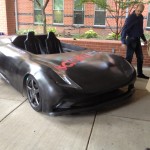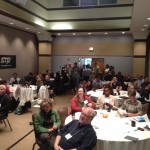<
p><img class=”size-thumbnail wp-image-1142″ alt=”Picture of me taking a picture of Sprint Zero of the Wikispeed workshop courtesy Elinor Slomba of Arts Interstices.” src=”http://test.devinhedge.com/wp-content/uploads/2013/10/2013-10-08-09.58.52-150×150 Picture of me taking a picture of Sprint Zero of the Wikispeed workshop courtesy Elinor Slomba of Arts Interstices.
Well, another year of AgileDC is in the can. This year was another winner. Even though the flavor at AgileDC is always biased towards the Federal Government, it was strange that the topics seemed to be diverse and more engaging than those at the Agile Alliance‘s Agile 2013. I confess that the topics at Agile 2013 were so non-interesting that I didn’t even go this year. This is not to say I didn’t miss something. I did. First of all I missed hanging out with old friends. There was also a few sessions that I would have liked to attended. For the money, though, AgileDC was a much better deal. Additionally, we raised some $14,000 for a cause I’m deeply passionate about, the Juvenile Diabetes Research Fund.
Wikispeed Keynote
This year, the keynote was just as engaging as last year. Joe Justice of Wikispeed filled in the gaps between Agile 2012 and today. Always willing to put others before self, Joe brought J.J. Sutherland* of Scrum Inc. to talk about how he used Scrum to manage NPR’s coverage of the Arab Spring in Egypt. According to J.J. the situation was so fluid that rather and unifying the reporters, it had a tendency to put reporters at odds with each other, causing missed deadlines and misinformation. J.J. spoke of being reminded of a technique his father forced him to learn by attending a Certified Scrum Master course: Scrum. J.J. talked about pulling out sticky notes and pulling the reporting team together twice daily. It worked and NPR’s coverage remained some of the most relevant and comprehensive. ( Transparency: I contribute funds to NPR so it is good to hear that my money is being managed well. )

Another thing from Wikispeed is the phrase “eXtreme Manufacturing”. I like where Joe and the gang are going with this. It has all the makings of changing the world in the same way that Demming did. Yes… I just went there. Expanding beyond building a car that is posed to reinvent how cars are designed and built, Wikispeed is starting to focus on another one of my passions, solving the problem of involuntary homelessness using eXtreme Manufacturing to build MicroHouses. One application I could see of this refugee camps, displaced peoples from natural disasters, and a way for cities to set up transition programs for those placed in involuntary homelessness situations. (NOTE: I probably should talk sometime about what we are learning about why these programs fail and how Habitat for Humanity has overcome these obstacles to success.) Throughout the day, Joe and the folks at Scrum Inc. used the Wikispeed eXtreme Manufacturing workshop to teach pairing, eXtreme Manufacturing, Scrum and Kanban.
Personal Experience

My session went perfectly. I’ve never had that happen before so I thought I would make note of it. I was presenting on the topic of Agile Failures, something no Agile Coaching account manager or business development person is likely to ever talk about. I expected the session, Lessons Learned From Five Years of Agile Implementation Failures, or… What NOT to Do When Becoming Agile, to have about ten people show up. Ten minutes before the session, it was full. Five minutes into the session, it was standing room only.
Needless to say, I was nervous. This was also my first public appearance under the ResultLinq Associates monicker. Would the audience get the message? That will still remains to be seen, but the feedback was overwhelmingly that I hit home. The feedback told me exactly what I expected. Everyone liked the format. The opening blew everyone’s mind. A lot of people were stuck in deterministic thinking headspace so they wanted a one-size-fits-all checklist when all that could be had are certain principles. Oh… and I thought the projector/screen combination was terrible, too. It made the smaller text unreadable and I was standing right in front of it.
I have to confess that I lied on one slide. The picture of an Agile adoption coaching plan was actually a release planning session. I couldn’t find my coaching plan pictures and had to substitute with something worked and looked the same as a coaching plan. I openly apologize and ask for forgiveness. I found the pictures today after some creative searching through my Dropbox history. I’ve updated the slide so that you can actually see what my coaching plan wall looks like.
Several folks have asked for the slides. I did one better this time around. Below is a corrected recording of the session and a link to the PDF of the corrected slides.
[vimeo 76835486]
Feel free to ask questions and challenge some of my hypothesis and theories.
Related articles
 How to be an Agile Coach(agileworldblog.wordpress.com)
How to be an Agile Coach(agileworldblog.wordpress.com)
 Agile is Easy, Transformation ain’t(radtac.wordpress.com)
Agile is Easy, Transformation ain’t(radtac.wordpress.com)
Post Disclaimer
The information contained on this post is my opinion, and mine alone (with the occasional voice of friend). It does not represent the opinions of any clients or employers.

